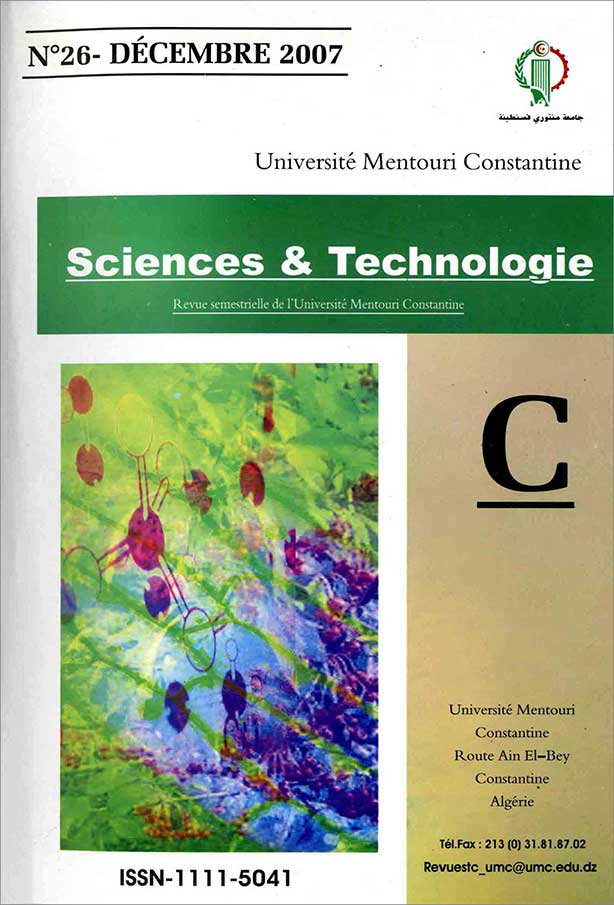ESSAI DE LUTTE in vitroPAR LE GLYPHOSATE CONTRE DES CHAMPIGNONS TELLURIQUES PHYTOPATHOGENES : FUSARIUMET PYTHIUM
الكلمات المفتاحية:
Fusarium oxysporum، Fusarium oxysporum f. sp. albedinis، Pythium، glyphosate، mycelial growth، reproductive organsالملخص
Cryptogamic diseases are considered as limiting factors of cereals, crop and forest production, because causing considerable losses. These diseases are caused by several species. The most frequently blamed belong to Rhizoctonia, Fusariumand Pythium kinds. These two last genus appear to be sensitive to an organo-phosphorated weedkiller: the glyphosate [1, 2, 3]. The tests carried out towards Fusarium oxysporum, Fusarium oxysporum f. sp albedinis(Killian & Maire)Gordon, and some stocks of Pythium, show that glyphosate concentrations tested (0.5 - 1 - 1.5 and 2 mM) decrease Fusaria mycelian growth until inhibiting it at 2mM concentration level; whereas
growth of Pythiumis inhibited from 0.5mM concentration.
Microscopic studies of the mycelial colonies reveal that 0.5 - 1 and 1.5 mM glyphosate concentrations increase Fusarium oxysporumconidia number; 1.5 mM molarity stimulates chlamydospore formation. Concerning with Fusarium oxysporum f. sp albedinis however, a
reduction in the number of conidia is observed at 0.5 mM; their absence at 1 and 1.5 mM is noted under the experimental conditions (T = 28°C, medium PDA). 2 mM concentration inhibits growing speed and reproductive organs production of Fusarium and Pythiumspecies.
المراجع
-Coupland D., Caseley, J.C., Presence of C14 activity in root exudates and guttation fluid from Agropyron repenstreated with C
labelled glyphosate. New Phytol., 83,(1979),pp 556-560.
-Gossbard E., Effects of glyphosate on the microflora with reference to the decomposition of treated vegetation and interaction with some plant pathogens. Pages 159-185 in E. Grossbard and D. Atkinson, eds the herbicides glyphosate.
Butterworthe, London, (1985).
-Lévesque C.A., Rahe J.E., Effects of glyphosate on Fusarium spp: its influence on root colonization of weeds, propagule density in the soil, and crop emergence. Can. J. of Microbiol.
,(1987), pp.321-324.
-Hendix J.W., sterols in growh and reproduction of fungi.Ann. Rev. Phytopath.,8, (1970), pp. 111-170.
-Kawate M.K., Kawate S.C., Ogg A.G & Kraft .J. M., Response of Fusarium solani f. sp. pisi and Pythium ultimumto glyphosate. Weed Science., 40 (1992), pp. 497-502.
-Ait Kettout. T., Amgoud. M.; Boucenna. B. et Rahmania. F., Effet du glyphosate sur la croissance mycélienne etles organes de reproduction de Pythium intermedium. Journées Techniques Phytosanitaires.INPV (2001) ;pp 242-249.
-Liu L., Z.K Punja and J.E.Rahe., Altered root exudation and suppression of induced lignification as mechanisms of predisposition by glyphosate of bean root (Phaseolus vulgarisL)
to colonization by Pythiumspp. Physiological and molecular plant pathology.(1997), 51,111-127
-Meriles J.M; Vargas Gil S; Haro R.J; March G.J; Guzman C.A. Glyphosate and previous crop residue effect on deleterious and benifical soilborne fungi from a peanut-corn-soybean rotation. J.Phytopathol .(2006),151,n°5;309-316.
-Cochran V.W., pages 377-380 in Physiology of fungi.John wiley & sons, New yourk, (1958).
-Sanogo S. Yang X.B and H.Scherm .Effects of herbicides on Fusarium solani f.sp.glycineand development of sudden death syndrome in glyphosate-tolerant soybean. Phytopathol (2000), 90: 57-66.
-Amgoud. M., Boucenna B. Ait kettout T et Rahmania F. Recherche de microorganismes antagonistes aux Pythium: Agent de fonte de semis et pourriture de racine.Journées Techniques Phytosanitaires.INPV (2001) ;pp
- Boucenna. B. Ait kettout T. Amgoud. M. et Rahmania F.Essais de contrôle de Pythium aphanidermatumpar Bacillus sp. Journées Techniques Phytosanitaires.INPV (2001), pp.203-241.


